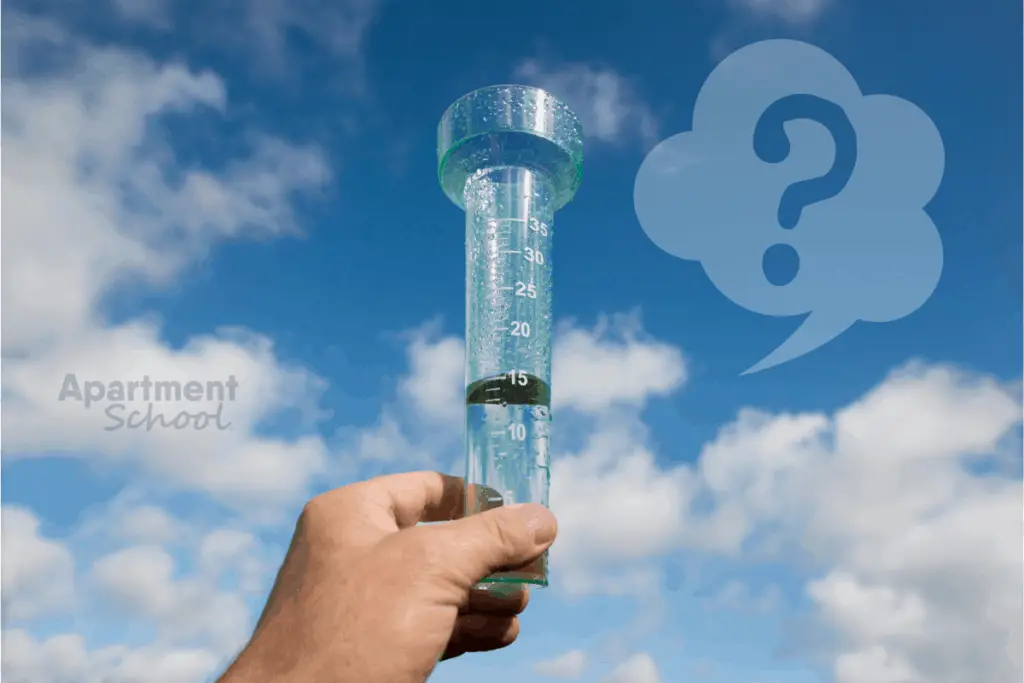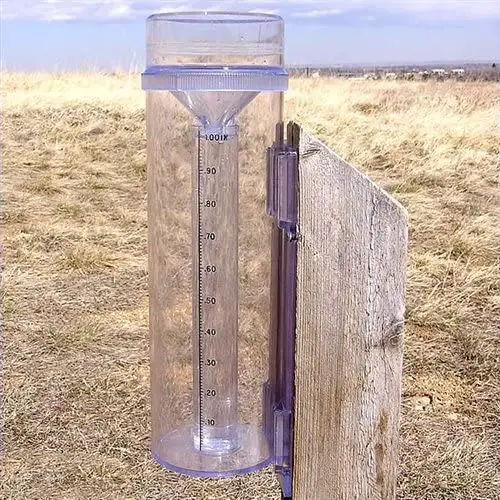
No matter whether you live in an apartment or condo or house, one of those frustrating things when it storms or rain is being able to know EXACTLY how much rain you got at your apartment or house.
Most of us just listen to someone on the radio, a podcast, or the news tell us how much rain an area got. Well, those figures are either JUST from the rain gauge outside their station, or more commonly, out at the nearest airport to their station because airports typically have good weather monitoring software.
They may SAY that this is the “official” rain amounts that fell in a particular city, but that is because, at some point, they have to choose someone’s rain gauge to be the official one. It doesn’t mean that that’s what YOU have at YOUR place.
But storms don’t just drop their rain in a uniform area across the entire listening area of whatever outlet you happened to be watching or listening to. Depending on the kind of storm, people only a few blocks away can get a significantly different amount of rain than you get at your place. The same thing happens when a frontal boundary comes through. Depending on which side of it you are on, one side of town could be getting rain and the other side be getting dumped on with snow.
Disclosure: This post may contain affiliate links and I may earn a small commission when you click on the links at no additional cost to you. As an Amazon Affiliate, I earn from qualifying purchases. Thank you!!
Whether you want to know whether your plants outside really got watered or not, or just be able to say for a certainty how much rain you got when talking to your friends, family, and co-workers, Apartment School has the list of rain gauges you should buy.
Types Of Rain Gauges
There are two main types of rain gauges, Analog and Digital. Analog gauges are the more traditional ones you check manually and then dump out. Digital ones typically send the information to your phone or computer and some automatically dump the water out after collection.
An Analog or Standard rain gauge is a completely manual process. These are the ones where, if it is still raining, you are going to have to go get wet to check how much rain you’ve gotten so far.
But don’t just rule these out simply because of that fact. These types are actually very accurate… as long as the opening in the top of your rain gauge, where the rain comes in, has a diameter of at least 4 inches. The accuracy goes up even further if you get an 8-inch diameter.
The National Weather Service says the standard for a manual rain gauge is 8 inches across. But with anything, the bigger you get something, the more you are going to pay for it. However, in the realm of rain gauges, we aren’t talking about a HUGE amount of money here.
With Digital Rain Gauges, you don’t have to do much of anything except check your phone, computer, or weather station to see how much rain you have gotten. Another big feature of digital rain gauges is that they can track how much rain you got in a single storm, in the day, the week, the month, and even the year. This way, you can quickly and easily see how much rain your place actually got, and when.
There are few wrong answers to buying a rain gauge besides getting one with a funnel that is too small, which is going to give you a false reading of the rain you got. The other thing you want to make sure to do is to mount them in the right place, which is what I am going to go over with you in the next section.
Where To Mount Your Rain Guage
You want to mount your rain gauge in a place that is free of obstructions, like under a tree or any part of a building awning, and make sure that it isn’t in the windiest place on your property as well, as wind will also give you false readings.
Obviously, you don’t want to put your rain gauge under anything that is going to prevent rain from falling into it. That kind of defeats the point. This means that if there are trees nearby, within 20 or 30 feet or so, that you don’t want your rain gauge here. When rain falls at even a slight slant because of the breeze, the canopy of the trees is going to affect how much actual rain is going to get into your gauge.
Additionally, you don’t want to put it in someplace that is completely exposed to the wind. Literally, the blowing wind will make your gauge not measure the actual rainfall accurately.
Place or mount your gauge on someplace that is sheltered from the wind, but not under any trees. Many times, a back porch or patio works well for this. If you are in an apartment, mounting it to some point of your balcony railing would be ideal. But try to keep it away from the building as much as possible to prevent it from blocking the rain just like the trees.
Which Type Of Rain Gauge Is Most Accurate?
The most accurate rain gauge are those with a sufficiently wide opening. This allows for the most accurate measurement of rain to be gathered by your rain gauge.
Now, there is a bit of math that is done when actually “measuring” how much an inch of rain actually is. This has to do with the width and height of the column that is storing and measuring the rain. I will let you go Google this yourself to see how the math works, just keep in mind that the ones with the bigger opening up top tend to be the most accurate rain gauge simply because they are getting a rain sample from a larger area.
Between digital and analog isn’t very significant, as most of the accuracy issues come from the diameter of the collector, the opening, rather than whether it is being read by a computer or directly by your eyes.
If anything, the digital ones are a BIT more accurate, because they can do accuracy more sensitive than what your eyes can read. If you value this accuracy, go digital, if you don’t really care about the last hundredth of an inch and just kind of want to know whether it rained or no, then an analog is going to be plenty good for you.
Rain Guage Recommendations:
Regardless of how precise or techy you want to make your rain-collecting experience, Apartment School has you covered for which rain gauges will work best in your apartment or condo.
Let’s go through the rain gauges we think will get the job done without breaking the bank…
Stratus Precision Rain Gauge:
The Stratus Precision Rain Guage is really the only analog or non-digital rain collector that we would recommend. The reason we are recommending this product is that it is a VERY durable product, simple to use, and can be mounted almost anywhere.
It has a 4’’ opening at the top and is accurate to 1/100th of an inch.
Nothing on this device is going to rust or fade. This is a rain gauge that is made to LAST. The company’s own advertisement claims that this is the last rain gauge you will ever need to buy.
The best thing about this one is how easy it is to use.
ECOWITT Wireless Rain Gauge:
The ECOWITT WH5360B Wireless Rain Gauge High Precision Digital 3-in-1 Weather Station with Indoor Thermometer and Hygrometer is quite the rain collector despite its long name.
At $49.99, you are almost into the Weather Station category, but unlike a weather station where you have a ton of different focuses and features, the ECOWITT is designed to keep rain collection at the forefront of the product.
The great thing about this collector is that it collects and saves rainfall and precipitation from a ton of different time intervals. So, you can see how much rain you have gotten in the last hour, day, week, month, or year. It also keeps 2 years of history inside as well, so you will be able to compare rainfall from past years to what you are currently receiving.
The wireless works well on this device. The packaging says that it will go up to 100 years, but for most apartments and condos, you aren’t going to need nearly as much. But this IS a good feature if you need to mount the actual collector portion of the device somewhere on the outside of your building not in easy reach.
Maybe the best feature about this collection is that it empties itself, so all you have to do is look on the display and see how much rain you’ve gotten. Done!
Check out the ECOWITT on Amazon and have it shipped right to your door!
AcuRite 00899 Rain Gauge:
The AcuRite 00899 is the best bang for your buck if you are looking for functionality without all the added design perks some of the other models have. At around $35 bucks on Amazon, this is where you get all your wireless functionality with a great rain gauge for an amazing price.
If you can get by without having the colored graphs you may never use on some of the other models, this one has almost the exact same functionality, it is just a simpler, more minimalistic approach to a rain collector.
The sleek and elegant design makes it easy to both mount and set the display without worrying about décor.
There is a reason that this rain collector gets mostly 5-star reviews. First off, it works really well, it is simple and will fit with almost any apartment or condo setting, doesn’t take up very much space, and has virtually ALL the functionality of models at a higher price. This is not a bad way to go!
La Crosse Tech Wireless Forecast Station:
The La Crosse Technology C85845 Color Wireless Forecast Station
Now, we are into full Weather Station territory, and these full-function devices are not to be overlooked. Once you have one, it is tough to go back to not having the information at your fingertips 24 hours a day!
The La Crosse is a great value for the money! It features a full-color display and gives you both the indoor temperature and the outside conditions with humidity. It also gives you the future forecast and has customizable alerts.
It comes in a great, compact package that just unfolds for you when it comes to Amazon. The wireless signal from the sensor, a feature that some people can have problems with, works great!
The specs say that it will go up to 100 yards, and while we haven’t tested the far end of the range, it has more than enough range to go through your apartment walls!
This wireless forecast station from LaCrosse is one of the best values you are going to find!
If you are interested in Weather Stations for your place, I have written an entire guide on Weather Stations and your apartment, which you can find HERE.
How To Stay Safe In Your Apartment During A Storm
One of the biggest questions we have gotten at Apartment School is “How To Stay Safe In Your Apartment During A Storm”. Some people are worried about tornados during the spring and summer months and others are worried about how safe they are living on the higher floors of an apartment complex during a severe storm.
If you have this question too and are wondering about what to do during a major storm and some very REAL things to do to improve your safety, I have two full posts that you will want to check out. The first is Are Apartments Safe During A Tornado? and Are Apartments Safe During A Severe Storm?




